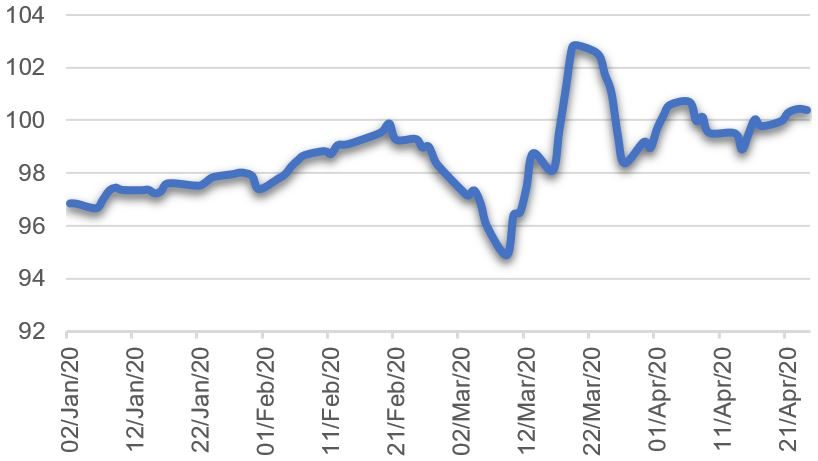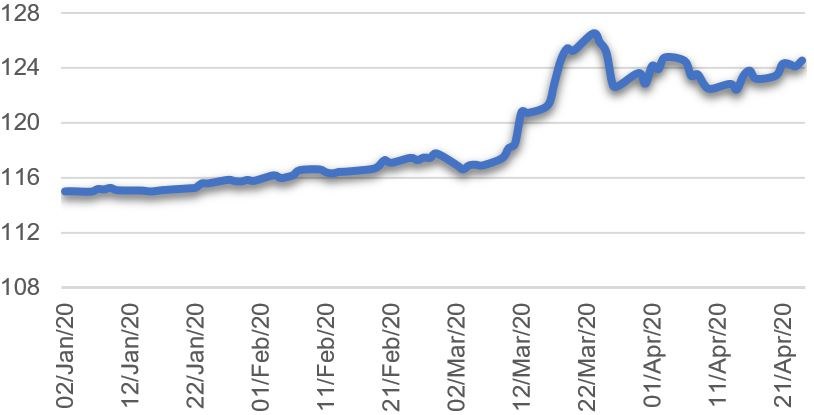Global Dollar Shortage: Back and Here to Stay
Published on 07 May, 2020

Amid the COVID-19 pandemic, demand for dollar – the global reserve currency – has increased. The recent turmoil in financial markets, a lack of liquidity and falling global trade has led to the strengthening of the US dollar vis-à-vis other currencies. The Federal Reserve has responded aggressively with interest rate cuts, quantitative easing and establishment of swap lines with major central banks to ensure liquidity and that the foreign exchange market functions smoothly. However, the measures proved inept in preventing the dollar index from touching an 18-year high. Is the dollar shortage a long-term scenario or a kneejerk reaction? Read on to find out.
The spread of COVID-19 pandemic impelled a worldwide rush to buy US dollars as the global trade suddenly ceased and financial markets fell sharply due to massive asset liquidation. From early to mid-March, the Dollar index rose sharply, reflecting unprecedented outflow of capital from emerging markets amid the highly uncertain and volatile environment. Investors were selling almost every asset and trading even in the usually very liquid markets for Treasury and agency mortgage-backed securities (MBS) were impaired. The short-term funding market was almost frozen. As investors looked for safe havens and dollar liquidity to meet their financial obligations, demand for the US dollar surged suddenly.
Many countries are struggling to service their dollar-denominated debt, as dollar inflow has stopped with international trade collapsing and commodity prices taking a hit. More than 102 countries have already approached the IMF for emergency funding in a bid to safeguard their economies from the shortage of the dollar.
|
The Dollar Index (DXY) |
FED Broad Trade Weighted U.S. Dollar Index |
Source: Bloomberg, Federal Reserve
What’s driving this sharp rise in demand for US dollar?
Governments around the world depend heavily on the dollar, which constitutes about 61% of central banks’ foreign exchange reserves and 40% of invoices. According to Bank of International Settlements, over the past decade, dollar-denominated foreign debt doubled to $12.1 trillion, or 56% of the US GDP in 2019, up from $5.8 trillion at the end of 2008.
US dollar denominated credit to non-banks outside the US (USD Trn)

Source: Bank of International Settlements
Majority of this new debt was raised by corporates and currency fluctuation risk was hedged by rolling-over short-term FX swaps. Interest payments on this new debt had to be paid in dollar, which generally in normal circumstances secured by the cash flows received from exports. During the coronavirus outbreak, however, as international trade collapsed, commodity prices tanked, and short-term dollar funding dried up with lenders turning risk-averse, funding and hedging costs increased substantially. Interest rates on cross-currency basis swaps, which track the premium paid for exchanging currencies for dollars, turned significantly negative in mid-March. Speculation of a global dollar shortage triggered panic buying and pushed the dollar higher.
Emerging market countries that depend largely on export revenue were most affected. So far this year the South African rand, the Brazilian real and the Mexican peso have lost more than 20% of their value against the dollar. According to the IMF, emerging markets will need at least $2.5 trillion in financial resources to get through the COVID-19 pandemic.
Currencies against the US dollar (YTD change)

Source: Bloomberg
How have measures announced by the Fed affected demand for the dollar?
The Fed has taken an aggressive stance toward tackling the crisis. It cut the target federal funds rate to zero for the first time ever and committed to purchase an unlimited amount of US Treasuries, mortgage-backed securities, municipal bonds and other assets. The Federal Reserve Board also reduced the reserve requirement ratio to zero percent.
After injecting more than $2 trillion to boost liquidity and ease funding pressures, the Fed’s balance sheet has now surpassed $6.6 trillion – the highest ever– from $4.29 trillion in the first week of March.
Fed Balance Sheet (USD Trn)

Source: Federal Reserve
The Fed acted like the central banker to much of the world and introduced a series of initiatives to support the supply of dollars in the international market:
- It established swap lines with 14 central banks around the world: Reserve Bank of Australia, Banco Central do Brasil, Bank of Canada, Danmarks Nationalbank, Bank of England, the European Central Bank, Bank of Japan, Bank of Korea, Banco de Mexico, Reserve Bank of New Zealand, Norges Bank, Monetary Authority of Singapore, Sveriges Riksbank, and Swiss National Bank.
- On March 31, it announced a temporary repurchase agreement facility for foreign and international monetary authorities. This enabled central banks to temporarily exchange their US Treasury securities held with the Fed for US dollars.
Most central banks have tapped the swap lines facility. The dollars borrowed from the Fed increased to more than $400 billion by the third week of April from less than $60 million in the first half of March. These arrangements provided some respite from the dollar shortage and reduced the strain on financial markets in the short term. It also restricted the dollar appreciation, as foreign central banks have been selling domestic currency to meet a rush for US dollars.
Will the US dollar shortage end soon?
The COVID-19 pandemic has reinforced the dollar’s dominance in the global economy for now and the foreseeable future. The promptness with which the Fed stepped in will strengthen the dollar’s position as an international reserve currency. The ongoing crisis has also proven that there is no acceptable alternative to the current system and the high dependence on the dollar would continue.
The severe shortage of dollars may only worsen in the coming years. Countries with strong external balance sheets, ample foreign exchange reserve and secure supply of dollars through swap lines can weather the storm. However, amid weak global demand, outflow of capital and depreciation of the local currency, companies and governments in emerging markets that need to access international bond markets to refinance foreign-currency debt may face significant challenges. Some of these countries do not have the required dollar liquidity to repay debt. The recent oil supply glut and substantial decline in oil prices would exacerbate the shortage of dollars globally, particularly for oil exporting nations that normally rely on global trade to service their USD-denominated debt.
Persistent tightening in financing conditions in the international financing market is likely to spill over to domestic financing markets. Monetary and fiscal measures taken by emerging market countries, such as cutting the interest rate and providing fiscal stimulus to mitigate the impact on the economy, would weaken their currencies. Investors are increasingly wary of investing in these economies. A further flight to the dollar will only cause more damage to the local currencies of these markets.
While the US Federal Reserve’s prompt and swift actions have curtained the panic buying of dollars in the short term, the central bank understands that shortage of dollars is a structural problem. Given the massive outstanding onshore and offshore dollar-denominated debt, expected wave of corporate defaults and higher volatility in financial markets, the dollar will continue to be the currency of choice for market participants—hence, its shortage will continue in the foreseeable future.


